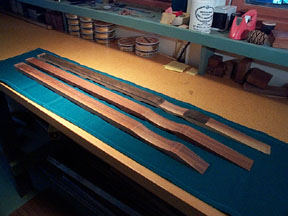The Dulcimer Fretboard
The fretboard is the dynamic spine of the dulcimer. Running the length of the body, its long, thin shape must be stable throughout the years of the dulcimer's life.
 The design of the dulcimer's fretboard is part of the reason that Bear Meadow Appalachian dulcimers have such dynamic, projective voices. We give special care to the fretboard. The piece of walnut chosen for the fretboard is critical. It must be straight-grained, well aged, dense, and accurately quarter sawn. A piece is selected months before-hand, and given a preliminary trimming up to get it square and straight. Each time you cut wood, internal strains are released, and the wood warps--no matter how straight the grain and no matter how long it has been aging and curing.
The design of the dulcimer's fretboard is part of the reason that Bear Meadow Appalachian dulcimers have such dynamic, projective voices. We give special care to the fretboard. The piece of walnut chosen for the fretboard is critical. It must be straight-grained, well aged, dense, and accurately quarter sawn. A piece is selected months before-hand, and given a preliminary trimming up to get it square and straight. Each time you cut wood, internal strains are released, and the wood warps--no matter how straight the grain and no matter how long it has been aging and curing.
So, the fretboard is laid aside for three to six weeks and then re-checked and trued up again. At best, this step results in a small adjustment to the straightness of the piece. About 10-15% of fretboards never get beyond this check. In these cases, the release of internal strain has been so great that further use as a fretboard is hopeless. Into the scrap pile such a candidate goes, to be used for braces and linings. For the successful fretboard, the next step is another couple of weeks' rest.
 After the fretboard has been fashioned and a proper profile has been worked into the top and bottom, the frets are installed. This is an exacting process, and cannot be hurried.
After the fretboard has been fashioned and a proper profile has been worked into the top and bottom, the frets are installed. This is an exacting process, and cannot be hurried.
 Next, the fretboard is joined to the top with light hot hide glue and screws. A lot of energy passes through this joint, so we don't want any failures here.
Next, the fretboard is joined to the top with light hot hide glue and screws. A lot of energy passes through this joint, so we don't want any failures here.
The last job on the fretboard is to cut a seat at the nose to take the little piece of bone I dovetail in to protect the wood where the strings come off the tailblock and up over the edge onto the ramp and up toward the saddle. This is a very sharp little detail, very impressive, but goes in about two minutes (once I got the technique down right).

